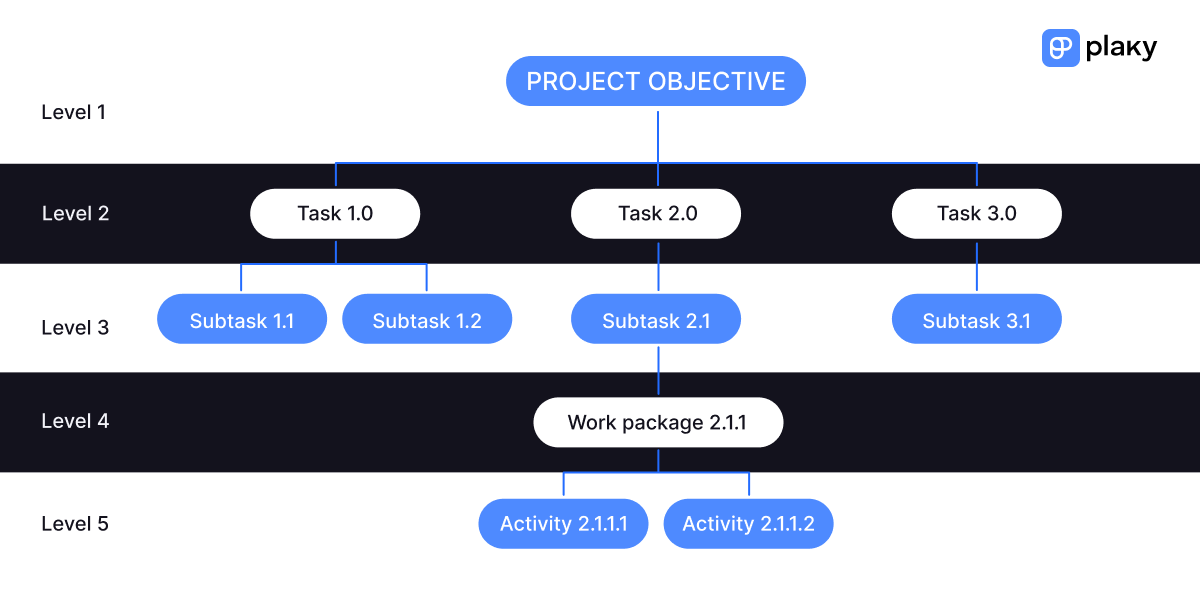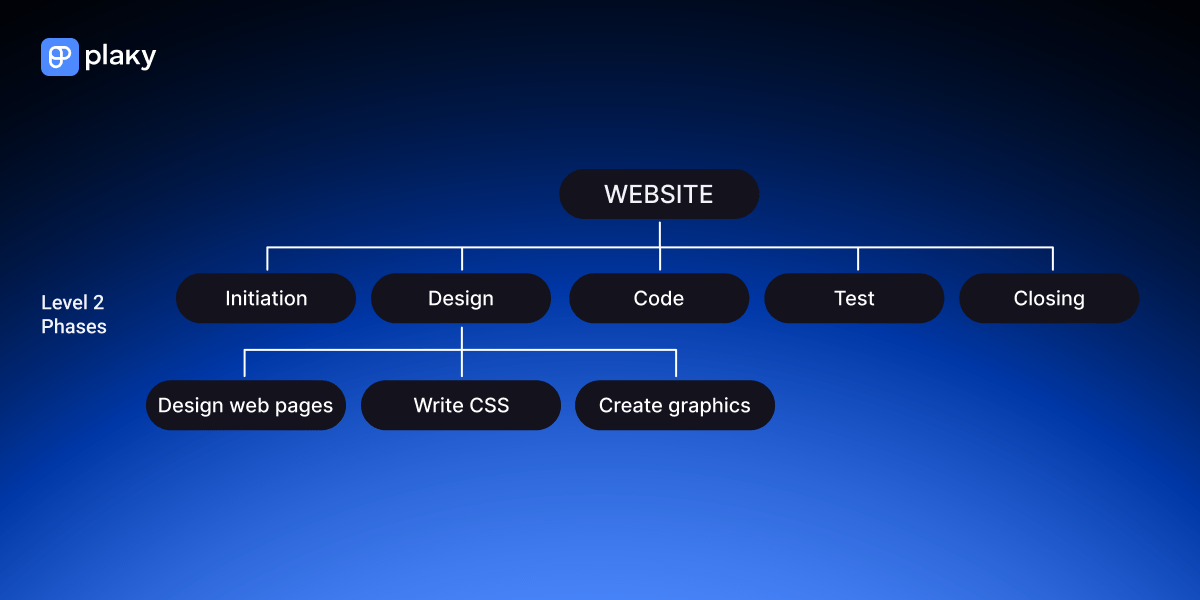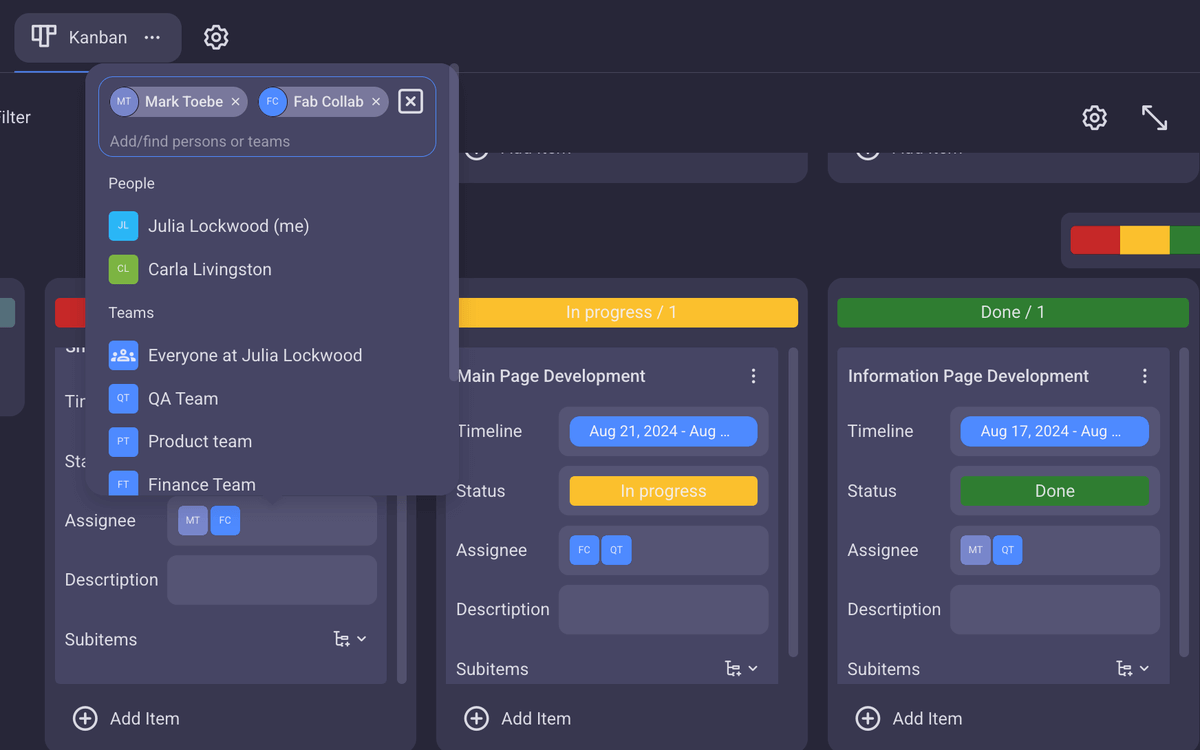The work breakdown structure is a document that project managers create when planning an upcoming project.
From organizing small events to building skyscrapers, the purpose of the work breakdown structure is to help split projects into tasks that are much easier to manage so that the team can achieve project success.
If you’re looking for tips on how to create your own WBS, you’ve come to the right place! Read on to find examples and expert insights.

- The work breakdown structure hierarchically decomposes an entire project.
- There are 2 types of WBS: deliverable- and phase-oriented WBS.
- Each WBS usually has 4 levels: the project objective, tasks, subtasks, and work packages.
- The structure should include 100% of the work needed to complete the project.
- Creating a work breakdown structure helps identify risks and prevent project failure.
What is a work breakdown structure (WBS)?
The work breakdown structure is a tool that breaks down a project into phases and deliverables using a hierarchical structure.
The WBS is usually depicted with a tree diagram, but it can also take the form of a list or a Gantt chart.
The main characteristic of the work breakdown structure is that it simplifies the project’s complexity by fragmenting it into smaller logical units. The WBS also takes into account the project constraints (scope, budget, and schedule).
With a well-designed WBS, managers and project teams can easily decompose complex projects and achieve their goals more efficiently. It’s also a great way to document any stakeholder requests in the planning phase.
Some of the benefits of using a WBS are that it:
- Eliminates uncertainty,
- Makes it easier to develop a project schedule,
- Sets clear benchmarks and milestones,
- Helps identify dependencies,
- Helps identify project risks,
- Improves team organization and productivity (WBS helps team members understand exactly what lies ahead, when, and why),
- Improves timeline and budget estimates, and
- Helps prevent project failure.
Components of a WBS
The key elements of a work breakdown structure are:
- WBS dictionary — a document that details all WBS items,
- WBS levels — representing the WBS hierarchy where the higher levels are the major project goals while the lower levels are specific activities,
- Work packages — the lowest WBS hierarchy levels, usually project tasks or subtasks with their assignees and due dates,
- Deliverables — outputs that result from project activities,
- Phases — project lifecycle stages, and
- Milestones — markers at certain points throughout the project that serve as progress checkpoints.
WBS dictionary
Since the WBS doesn’t contain additional information about the deliverables or tasks, project managers can create the WBS dictionary. This document contains all the minute information about every item in the WBS, including:
- Estimated duration,
- Estimated cost,
- Due date,
- Acceptance criteria,
- Dependencies,
- Approvers, etc.
However, not every project needs a full WBS, as Elizabeth Harrin, APM Fellow, project manager, and author, says:

“A full WBS involves a lot of documentation, for example, the WBS dictionary. Sometimes, smaller projects don’t warrant that level of rigor, and you can get away with doing a simpler, more straightforward exercise where you do break down the work, but you create a basic list instead of a complete WBS.”
WBS levels
The work breakdown structure is a hierarchical decomposition of the project that usually consists of 3 or 4 levels. The top level refers to the project’s goal, while the lower levels consist of phases or project deliverables.
Here’s how Elizabeth Harrin explains WBS levels and related project decomposition:

“A WBS starts at the top level with an overall goal for the project. You then create other levels that help you decompose the work to do into manageable chunks, starting with major deliverables and splitting them up into smaller deliverables.”
The naming conventions of the WBS levels sometimes differ from organization to organization.
So, in this article, we’ll rely on the hierarchy provided by the expert we talked to, Dr. Michael J. Shick, PMP-certified assistant professor of project management.
According to him, the WBS hierarchy usually comprises these 5 levels:
Level 1: Project — the project objective that the project manager and the project team want to create,
Level 2: Tasks — the project’s main deliverables or phases,
Level 3: Subtasks — mid-sized tasks or deliverables that can still be further divided into smaller WBS units,
Level 4: Work packages — the smallest units or deliverables in a WBS that can be assigned to an individual or team, also called terminal elements, and
Level 5: Activities — optional or project-dependent part of a work breakdown structure.

As Dr. Michael J. Shick puts it:

“Level 4 work packages are those items that can be completed and “delivered.” This is the level where a project manager assigns individuals and resources. Further, work packages have start and end dates.”
That said, he also indicates that, depending on the project, your WBS can have the optional level 5 too.
According to him, “level 5 is the actual activities to be performed by the project team members who are assigned.”
Elizabeth Harrin says the number of levels your WBS ends up with depends on how much structure you need:

“I stop when the activity on the WBS feels like it would take about a week, or it falls within the responsibility of a single person to do. You don’t want to create so many levels that your tasks are broken down into tiny pieces that take hardly any time because that is difficult to manage going forward. Ultimately, you need as many levels as it helps you structure the work and control the project.”
Types of work breakdown structures
There are 2 types of work breakdown structures in project management:
- Deliverable-oriented, and
- Phase-oriented.
Visually, the 2 WBS types can look the same. The main difference between them is whether you want to fragment the project by scope or schedule.
There are no specific rules about using one type of WBS over the other. This entirely depends on the type of project, the organization, and the preferences of the project manager.
#1 Deliverable-oriented WBS
A deliverable-oriented work breakdown structure divides the project scope into its main logical areas and then breaks down each area into deliverables.
Here’s what a deliverable-based WBS would look like for a website building project:

#2 Phase-oriented WBS
The phase-oriented work breakdown structure lists the phases of the project’s lifecycle and the activities that comprise those phases.
This type of WBS is a good choice for projects that involve sequential, stage-like phases, such as those in product development.

In the example above, level 2 highlights the main project phases (initiation, design, code, test, and closing phase).
These phases are then decomposed into specific tasks you have to complete to achieve your project goals.
💡 Plaky Pro Tip
Managing a project means inevitably encountering both internal and external risks. Learn how to manage risks successfully with our guide:
How to create a work breakdown structure
Creating a work breakdown structure is an essential part of the planning process. The basic framework includes the following steps:
- Define the project scope and objectives,
- Define the level 1 elements,
- Decompose the deliverables,
- Define the work packages, and
- Review, refine, and document the WBS.
Let’s go through each step in more detail.
#1 Define the project scope and objectives
To determine the key project objectives, you must first define the scope of the project and thoroughly understand:
- The project’s intended direction,
- Project goals, and
- Project stakeholders and their responsibilities.
In regard to the creation of the WBS, Dr. Michael J. Shick highlights the importance of involving the whole team:

“The project team, functional leads, and project manager should be involved with developing the WBS. This ensures the benefits of the diversity of thought are maximized, and all work is identified.”
The project team, stakeholders, deliverables, and scope should be documented in the project charter.
💡 Plaky Pro Tip
While the project charter lays out the whole project in broad strokes, the project management plan goes into the details of all the project phases. Learn more in our guide:
#2 Define the level 1 elements
Once you understand the scope, you can move on to identifying the project’s main deliverables.
According to Dr. Michael J. Shick, this step requires you to “create a list of all the major outcomes (i.e., product/service to be delivered) agreed upon with the customer/client.”
As soon as you and your team are clear on the main deliverables, you can start decomposing them into smaller units.
💡 Plaky Pro Tip
Need some tips on how to collect all the necessary information on your project’s objectives? Check out this guide:
#3 Decompose the deliverables
Once you have the main deliverables, begin breaking them down into smaller, more manageable, independent sections.
Make sure you don’t duplicate entries in this step. Remember to also consult the experts in your team to ensure the WBS covers 100% of the project work and that there are no overlaps.
#4 Define the work packages
Now you can distribute the work you have so meticulously broken down into bite-sized management units.
According to Dr. Michael J. Shick, in this step, you “identify the actual work to be performed and assign personnel, schedule (i.e., dates), cost estimates, and performance measurements.”
💡 Plaky Pro Tip
To help keep your cost estimates in check, you may want to consider using a cost forecasting method called estimate at completion (EAC). Read more about it here:
#5 Review, refine, and document your WBS
Once you finish the WBS, you should review it to identify any gaps that might have slipped under your radar. But that’s not the end of the process — you should refine your WBS throughout the project too.
According to Eric Risner, PMI Agile Certified Practitioner and Scrum Master, it’s not in the nature of a WBS to be fixed:

“The business landscape is rapidly changing, [and] so are individual projects. Stakeholders may update their expectations, budgets can be raised or lowered throughout the project lifespan, and other outside factors can impact a project’s timeline and priority. Because of this, I always recommend that project managers not treat their work breakdown structure as immovable. PMI research shows that project managers must be increasingly agile, even if they are using a Waterfall or predictive way of working.”
Finally, you should also write an exhaustive document (the WBS dictionary) that thoroughly explains each item listed in the WBS. This document should, apart from explaining the work, contain information about:
- Required project resources,
- Milestones,
- Assigned team members, etc.
In this step, Dr. Michael J. Shick highlights project assumptions and constraints in particular, saying that “any key assumptions and constraints related to the WBS should be identified and articulated.”
💡 Plaky Pro Tip
If you’re a fan of Excel, you’ll love the fact that you can also create your WBS in it. We’ve prepared some templates to help you in the process. Find them here:
Work breakdown structure example
Let’s illustrate the process of making a work breakdown structure with an example.
We’ll take a team building event and turn it into a phase-oriented project that involves planning and executing.
| Level 1 | Annual team building event | |||
|---|---|---|---|---|
| Level 2 | 1.0 Initiation | 2.0 Preparation | 3.0 Execution | 4.0 Closing |
| Level 3 | 1.1 Create a timeline 1.2 Make a guest list 1.3 Set the budget 1.4 Coordinate the planning team | 2.1 Create the program 2.2 Book the venue 2.3 Arrange the transportation 2.4 Hire a caterer 2.5 Book the entertainment | 3.1 Welcome guests 3.2 Enjoy the event 3.3 Say goodbye | 4.1 Send follow-up surveys 4.2 Discuss future improvements |
In this example, the WBS has 3 levels:
- Level 1 — the project’s objective,
- Level 2 — the project’s phases, and
- Level 3 — subtasks presented in each of the 4 columns and numbered accordingly.
As you can see, the WBS gives you an idea of how the event should be prepared and executed. However, for more details, you have to refer to the WBS dictionary.
This team building event plan is a simple example of a 3-tier WBS. After finalizing each of the work packages within a phase, you complete a phase. Completing all 4 phases marks the end of the project.
💡 Plaky Pro Tip
WBS is one of the most used project management techniques out there. Check out some other popular project management techniques here:
7 tips for writing a work breakdown structure
The way a WBS is created greatly depends on the project manager and the organization. Still, there are a few rules and guidelines to follow when writing a WBS.
These include:
- Including 100% of the work in the WBS,
- Ensuring same-level items are independent of each other,
- Avoiding duplicating the WBS elements,
- Adhering to the 8/80 rule — work packages should require no less than 8 hours and no more than 80 hours to complete,
- Using a coherent coding scheme — each WBS element gets a unique identifier, which enables easier control and monitoring of the project and its scope,
- Keeping it detailed but easy to understand, and
- Not overthinking it.
As explained by Dr. Michael J. Shick, the WBS must be easy to comprehend:

“The WBS is the foundation of effective project management, and because of that, a project manager should ensure they are detail-oriented by identifying the necessary details appropriate for the level while not overwhelming. The naming convention should be clear and concise, deliverable-oriented, and distinct, and it should not use technical language so it is easily understood by stakeholders. There should not be any confusion or overlap in the work that must be completed.”
Work breakdown structure vs. project plan
The work breakdown structure is not to be confused with the project plan.
The project plan is an element of the scope baseline along with the scope statement and the WBS dictionary.
The key difference between a WBS and a project plan is that a WBS divides the project into multiple, controllable elements. Meanwhile, the project plan enacts a framework for project planning, execution, monitoring, and controlling.
📖 Want to learn more about documents and project management terms like the WBS and the project plan? Check out our Project Management Glossary of Terms to explore basic and advanced PM terminology.
Structure and manage your projects with Plaky
Creating a WBS for your projects and organizing your tasks is much more efficient with project management software like Plaky.
Tools like Plaky are easy to use and have all the functionalities needed to bring your project management game to the next level.
You can use Plaky to:
- Centralize project data and ensure all information is available at all times,
- Organize your projects within boards,
- Correspond with teammates and manage your team’s work in real time, and
- Store and share files and documents in one place.
With all this data at your fingertips, you’ll be able to easily create a flawless WBS and jumpstart your projects fast!

Dr. Michael J. Shick also says that using software helps with updating the WBS:

“Remember that the WBS is dynamic and will require updates; therefore, it is helpful to leverage software or tools that will assist in creating, providing a visual representation, and managing the WBS.”
Ready to create your first work breakdown structure? Start your free 14-day Plaky trial and manage tasks, collaborate, and review progress with ease!
How we reviewed this post: Our writers & editors monitor the posts and update them when new information becomes available, to keep them fresh and relevant.

